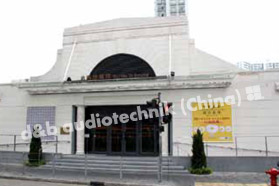Cultural Renovation - YMT Theatre
2013-07-29
Located in a historic part of Hong Kong, the Yau Ma Tei theatre has reopened its doors following a complete renovation. Caroline Moss reports
d&b audiotechnik china has installed a new sound system into the historic Yau Ma Tei Theatre in Kowloon. The theatre, which predominantly stages traditional Cantonese opera, opened in 1930 to fulfill a need for cheap entertainment in a city whose economy had yet to develop. Many people facing hardship turned to film as an escape from reality, and the Yau Ma Tei started life as a movie theatre which also hosted kung fu and dance performances.
During the Japanese occupation of Hong Kong from 1941 to 1945, the theatre remained open. After surrender the theatre changed direction slightly, screening the Hong Kong films which started to emerge and which heralded a golden era of cinema for the region, as a British colony, Hong Kong developed into a filmmaking hub for the Chinese-speaking world. Sadly, by the 1980s, this was in decline. The rise of home entertainment contributed a deathblow to Hong Kong cinemas, and Yau Ma Tei Theatre struggled to survive. In a bid to continue, Japanese pornography was played between scheduled movies, and by the end of 1987, the theatre’s business was entirely based on this king of content.
However, even this strategy didn’t guarantee the building’s future. By 1998 the theatre’s doors were closed and its days as a cinema were over. But several years later, fate intervened in the shape of a Grade 2 historic building status by the Antiquities Advisory Board. This has led to the building being preserved as the only surviving pre-war cinema in Hong Kong. Renovation work began in 2009 to preserve the theatre’s unique design. This incorporates elements of classicism and Art Deco, with notable features including pillars to either side of the entrance engraved with Chinese opera masks, and a traditional proscenium arch. And in a city where concrete, steel and glass prevail, the theatre’s construction from brick, granitean timber, the most common materials available in the early 20th century, is also notable.
In 2012, the Yau Ma Tei Theatre reopened its doors to the public and is now one of 11 government-owned theatres in the city, nine of which are installed with d&b sound systems. The theatre’s raison d’etre is to serve the community in one of Hong Kong’s most traditional and historic areas. Today, the majority of the theatre’s programing is Cantonese opera, with some occasional drama. It has also become a place for students of Cantonese opera to study the genre. So it was imperative that the building’s acoustics were handled sensitively, and a sound system installed which would do justice to the historic art form being preserved and continued by the theatre.
d&b worked closely with Hong Kong-based system integrator PCCW Solutions to design a sound system for the 300-capacity theatre. Alex Poon from d&b China provided speaker system design and support for PCCW, liaising with the company’s system designer Zachary Cheng. Also involved in the renovation was Mr Him Tang from local acoustic consultants ShenMilsom and Wilke, who handled the acoustic treatment.
‘The Yau Ma Tei Theatre required a system which would provide good quality, even coverage of the auditorium and would bepowerful enough to reproduce the very loud Chinese percussion musical instruments,’ says Mr Cheung. ‘Mr Alex Poon gave us a lot of good advice and provided design proposal during design stage. We needed to use small speakers which were very good quality and could provide high SPLs. Because the theatre is designed for Chinese opera, the quality of vocal and music reproduction was very important in this installation. And because space is limited and the speakers could not be obtrusive in any way, size was very important too.’
The new sound system comprises two d&b E12-D two-way loudspeakers as the main centre cluster, with an E12 and E15X-SUBsubwoofers either side as a left-right system. Along the orchestra pit rail at the front of the auditorium, five d&b 4S full range compact speakers have been installed for front-fill. Additionally, d&b E8s are used as stage monitors, while three E6s and eight Eos – the company’s smallest speaker – are available as mobile monitors for stage, music pit or front-fill. The system is powered by three d&b D6 dual-channel amplifiers and controlled via the R70 wireless remote.
Apart from the d&b elements, local suppliers including ACE, Tom Lee Music and Sound Works and Supplies provided a complete package of new audio equipment. The theatre’s control room has been installed with a Soundcraft MH3 mixing console with 40 mono and four stereo inputs, 12 auxs, eight groups outputs and 12 x 4 matrix outputs. Outboard equipment includes a Lexicon MX300 digital reverb unit, a TC Electronic Finalizer 96k studio processor, a Shure DFR22 feedback eliminator, a Shure DFR22 feedback eliminator, a Presonus ACP88 eight channel compressor/ limiter/ gate, six Hirosys HB-BL2 stereo balancing, unbalancing and level-shifting interfaces, a Canford Audio Pro-Interface MK2 rack mounting stereo interface and six Drawmer DA6 balanced audio distribution amplifiers.
There is also a wide choice of microphones, including Shure SM58Ss, Beta 57As and Beta 58As; Neumann KMS 105s, KM 184s and KM 185s; Crown PCC-160s, AKG C 214bS, C 411 PPs and C 519Ms; Audix D6s and Audio Technica ES915ML15s and AT8015s. The wireless mic system consists of six Sennheiser UNF SKM 2000-BK handheld transmitters and 10 Sennheiser UHF SK 2000 body-packs.
The results of Yau Ma Tei’s renovation are clear to see. From the carefully preserved architectural features through to the powerful but carefully concealed audio system, the theatre is a well-preserved slice of traditional Chinese culture that should please and educate future generations.
*Source from Pro Audio Asia magazine Issue 2013 May-June